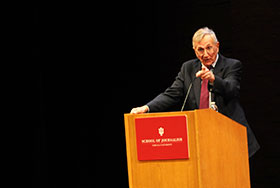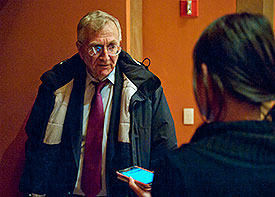Hersh describes investigative process, ethical considerations
By Jessica Williams

Discussing “the story about getting a story,” Pulitzer Prize-winning journalist Seymour Hersh delivered the School of Journalism’s Roy W. Howard Lecture Wednesday night in downtown Bloomington.
As the first of the school’s Speaker Series guests, the journalist and author spoke at the Buskirk-Chumley Theater to a full house that included area residents and students. He shared a play-by-play discussion of the reporting that resulted in his exposing the Vietnam era My Lai massacre, work that earned him the 1970 Pulitzer Prize for investigative reporting.
Though Hersh went on to break more stories, including military and government exposes, and to write several bestsellers, in 1969 he was a freelancer with a few years of reporting experience on police and military issues.
Like the genesis of many good stories, rumors about a military massacre intrigued Hersh.
“I kept on poking and I didn’t really go anywhere, really,” he said of his initial reporting. He worked his military contacts, taking caution so government officials, whom he believed tried to cover up the massacre, wouldn’t know what he was doing.
He discovered that Lt. William Calley led a unit that killed hundreds of civilians near the Vietnamese town of My Lai. Calley was to stand trial for 109 counts of premeditated murder of “Oriental human beings,” Hersh said, and he told the crowd how he tracked down Calley for an interview through a twisted path of sources.
“It’s all about making your own luck,” Hersh said of following the smallest lead, reading everything from newspapers to public documents to find the merest thread that may help unravel the story. A chance meeting with a low-ranking officer, who just happened to be the person who collected and delivered Calley’s mail, led to Hersh’s finally finding Calley.

Through his diligence, Hersh was able to write five stories in five weeks. More difficult was finding news outlets to buy his work. His rate: $100 each time a story was used.
But Hersh also wove into his talk the ethical considerations of the 1960s-style reporting of a young journalist. The audience laughed at his term, “oxymoron of journalism ethics,” but Hersh admitted he was at times “less than candid” with sources. He didn’t always explain that he was a reporter working the Calley story, for example, to gain access to people.
He described masking quotes at the request of a military source to hide the fact he interviewed Calley. Calley had provided inconsistent information to Hersh, and the official worried that this information would prevent or limit Calley’s prosecution.
Hersh also recounted the story of “the folder.” He managed to land an appointment with a military official who thought Hersh was reporting on a vague military matter, and when Hersh shifted the questions to the Calley case, the official pulled out a folder. When the official left the office for a phone call, he left the folder on the desk.
“What do you do?” Hersh asked the students in the audience, whose most audible responses were “open it.” Then Hersh presented options: Would you open it if it were in a drawer? In a cabinet file? In a locked cabinet file?
Turns out that not only was the file on the desk, it was open to the first page: Calley’s charge document. Hersh said he stayed in his seat across the table, read the document upside down and took notes.

“One of the perils of what we do is we get close to the edge,” Hersh said, adding he has always done what he thought was right at the time.
Katie Mettler, a junior journalism student and investigations editor at the Indiana Daily Student, welcomed the audience Wednesday night. She said Hersh taught her there is no “magic bullet” for investigative reporting; it’s about being diligent and not taking no for an answer.
Freshman journalism student Tamara Milic and her friend Claire Russell, also a freshman, said they learned about something they didn’t even know happened – My Lai – and Milic plans on finding out more about it. A non-journalism student, Russell said she also learned a lot about the reporting process.
Hersh continues his investigative work, most recently delving into military issues in Iraq and Afghanistan, and is a contributor to The New Yorker. His books include The Price of Power: Kissinger in the Nixon White House, The Dark Side of Camelot, and Chain of Command: The Road from 9/11 to Abu Ghraib.
Hersh was the first guest of the school’s spring Speaker Series, which brings top journalism professionals to the area for talks that are free and open to the public. Next up are PBS and NPR journalist Maria Hinojosa March 5 and David Sanger of The New York Times March 28.

